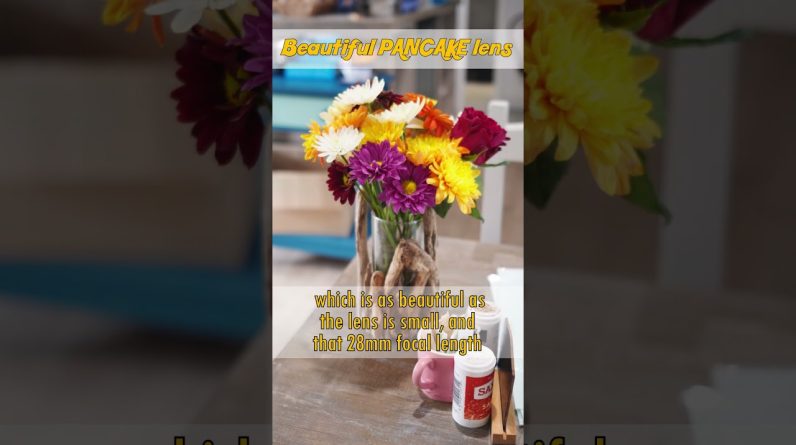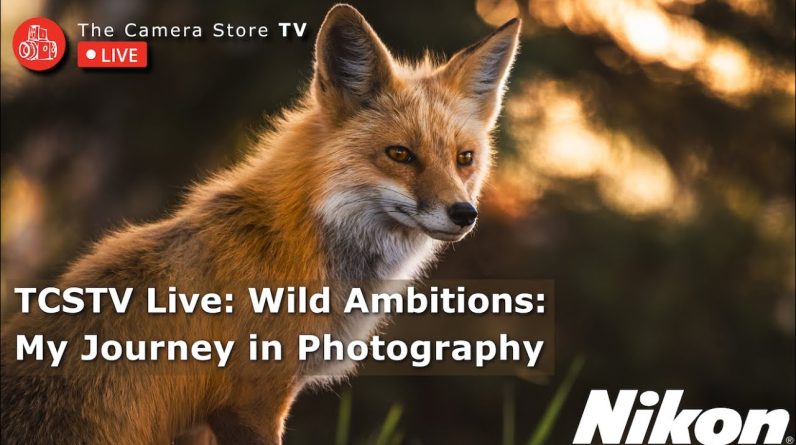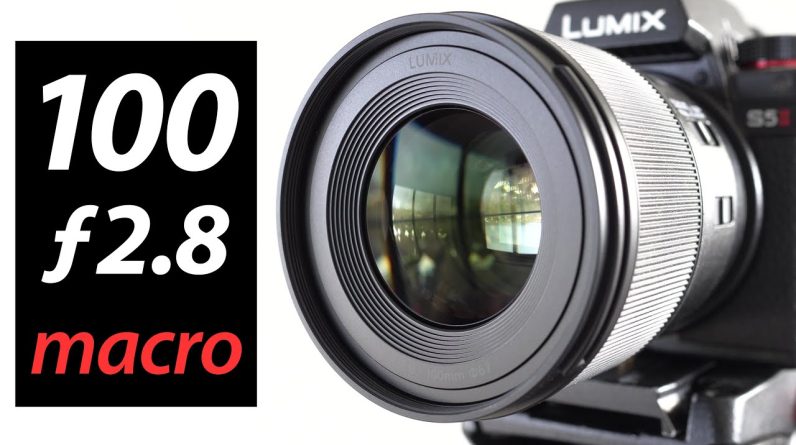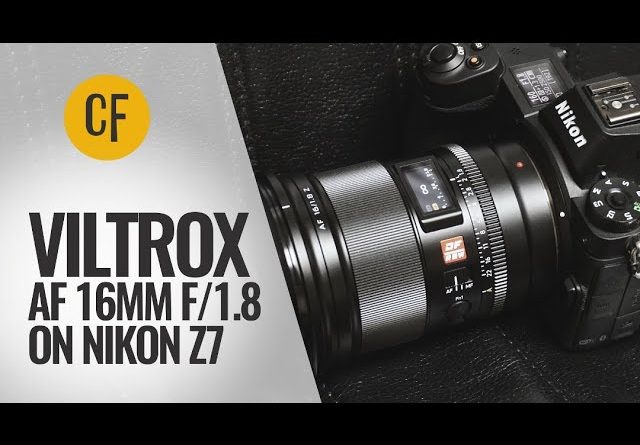This is the Tamron’s
new 20-40mm f/2.8 lens For Sony E-mount, And if you would have
asked me a couple years ago To describe my dream lens, On paper, this would be it. Let’s get undone! (upbeat music) ♪ Gerald Undone ♪ ♪ He’s crazy ♪ What’s happening, everybody? I’m Gerald Undone and it
was me all along, Barry. For disclosure, Tamron lent me this lens
to make this review. I don’t get to keep it, No money exchanged hands, And Tamron does not get any
input on this video’s production Or get to preview it before it’s posted. Essentially, I just wanted
to try it for myself To see if I was gonna buy it And figured I’d share my
thoughts with you along the way. I’ve had it for a couple weeks now. I took it with me to New
York as my only glass To see how it felt as a walk around lens. And I’ve used it in a
few other applications That I’ll share with you a little later. I like the build quality of
this lens and the handling. It balances nicely on the
latest full frame Sony bodies. The rings are only lightly dampened, But they feel good to me, And I haven’t noticed any
barrel sag from gravity Pulling out the zoom. Although this lens actually
extends when going to 20 mm, And is retracted at 40 mm. The only thing I don’t
like about the build
Is the lack of any switches. There isn’t even an AF/MF switch, So you’re gonna have to do
everything on the camera. The front filter thread is a 67mm And the lens weighs 365 grams. Tamron claims that it’s moisture resistant And has several seals to prevent leaks Throughout the barrel. And even the USB-C port is waterproof. Now I didn’t use it in
extremely inclement weather, But I did have it in the rain for a while, And it was perfectly fine. And speaking of that USB-C port, This is one of my favourite features Of the new Tamron lenses, Including that 35-150mm lens that I adore. You can connect your lens To Tamron’s software very
easily with just a cable, Without needing any kind
of docks or adapters And adjust a bunch of valuable
settings on your lens. The most important ones are
the direction and linearity Of your focus ring as well as the throw. So you can make it completely linear And set the travel to 90,
180, or even 360 degrees, Which makes manual focusing
excellent on this lens. However, it’s not parfocal. Meaning you don’t keep
your focus as you zoom. It’s close, but it’s not perfect. It’s probably good enough
that on a wide shot You might not notice too much, But if you shoot anything close
up or with a lot of detail You can see that the focus
is off after zooming. If you’re using auto focus,
this isn’t a big deal As the VXD linear motors in
this lens are fast enough
To keep up with changes in focal length. Unless you’re just crash zooming
in and out like a madman, In which case, this is
not the lens for you. You can close focus down to
17cm or 6.7 inches at 20mm; And 29cm or 11.4inches at 40mm. This will give you a
maximum reproduction ratio Of approximately 1:4 and 1:5 respectively. So definitely not a macro lens, But you can get some
reasonably interesting Close focused shots At the wide end of the lens. Auto focus performs quite well. As I mentioned these are
Tamron’s latest linear motors So you can rack from minimum
to infinity almost instantly. And the motors are
smooth for use in video, But there is some focus
breathing to be aware of. It’s definitely not the worst I’ve seen, But it is noticeable in some shots. I recorded a tape measure here So you could get a sense of
how much of the frame is moving As you rack focus. And the results are about the same At both ends of the zoom range, But the effect is different
because of the magnification And field of view. And unfortunately, as far as I’m aware, There is no support for third-party lenses With Sony’s focus breathing compensation, So you’re stuck with the breathing as is. But let’s put it on my main camera here And see if it poses an issue
in talking-head scenarios. Okay this is at 20 mm And then 40 mm
And then we’ll pull back to 35. Okay, so this is that lens set to 35 mm. I showed you the 20 to 40 zoom
range there ahead of time. I think this is close to the
frame that I had set up before. Let’s see how the focus breathing plays. If we can see it. If you just move around a
little bit with talking head, It should be tracking my eye. If I move close, So it’s not too bad. It seems like the breathing Falls more on the
really, really close end. If I get up close. Let’s see. Yeah, so it breathed there. So if you’re at a reasonable distance Then these movements Shouldn’t be too distracting in the frame. Like I do see it move a little bit But it’s not as bad as like When I had the the 35mm G Master on If I did this, you know, the whole frame Was like coming in and
out, so that’s not too bad. One thing I am noticing though Is obviously I had to bump the ISO. I normally shoot on the 35mm 1.8 And I shoot it at f/2.2. So I had to bump the ISO and I noticed That even in New York
when I was walking around In fact the last time I was In New York I was using a 20 millimeter. It was the f/1.8 prime from Sony. And there’s a big difference
in that one in a third stops. I’m telling you, when you go
Out in an evening or
nighttime, you like the 2.8. I kept having to jack up the ISO And the shots were noisier
and stuff like that. So, but I mean overall
this is, this is fine, This would work, you know,
this is okay, is adequate I just have a little bit higher iso I don’t love that like a 2.2. I find the background
gives me more separation. I can go all the way to 1.8,
2.8 on 35mm of this distance. The background’s there like it’s It’s only slightly outta focus. So I don’t think I would
use it for this shot. I think I prefer to shoot it Like I said, f/2, f/2.2,
somewhere in that zone. But it looks good as far As image quality and color and, and again The focus breathing isn’t too bad And the auto focus is doing well To smoothly stick to my eye. So performance wise it’s great. Just comes down to taste
whether you need more separation Or you know, you wanna expose differently. All right, let’s talk about image quality. I’ve got some choice samples
here in light room to go over. These first two are just
to give you representation Of the difference between 20
millimeter and 40 millimeter. This was more to talk about distortion. I’ve noticed that when
I was shooting sort of Like architectural stuff in New York That there is a lot of distortion Which I didn’t find as
bad on my 20 mil prime But there aren’t correct
lens correction profiles yet For this lens. So you know, I can try and ma–
I can try to do my own
distortion correction In Lightroom and it works. But I just wanna let you know That there is some weird stuff going On as it currently stands. So you’re gonna have to do that
manual if you wanna fix it. Same with here, just
like look at the windows It’s not so bad at 40 mil But I would say from 20 to 30 it exists. This one was at 30 mil actually. And then I did some
portraits, goofy portraits With Ifondo to sort of be
able to get a look at the The bokeh in the background
but also see, you know What the eye sharpness looks
like in that kind of thing. So this one was at 40 mil. And this also goes to show
the magnification differences And I believe these are
both somewhat close focused Like about as close as I get
the auto focus to grab the eye. So this is 40 mil. We can punch in And this is what the out
of focus orbs look like. And also, yep, reason I, nothing About this lens screams super
sharp, but it’s, it’s okay. Like they’re all sort
of like reasonably sharp But it’s not like 35
millimeter G master sharp Kind of thing, you know? But we’ll get in a more
sharpness detail in a minute, But this is okay. And then at 20 mil obviously Is a much different perspective. That distortion comes into play now. I would say at 40 mil it’s not
really that distorted at all Kind of almost looks natural. But then here we’re getting
a, you know, a different look. It’s still managed to be quite
Quite sharp and decent on
the eye there, which I like. And I would say the bokeh is about the same Except for 20 mil. We can start to see the
blades a little bit more In the out of focus areas. Both of these were at 2.8, so
this is as big and you know Round as the orbs are
gonna get on this lens. And then I don’t know what
this one is, is this anything? I think maybe I was
messing around with flare. I have mixed opinions
regarding flare on this lens. It comes with a hood, which is good Because if you manage to catch
some flare with this lens It tends to be really,
really, really strong. I did that test with a flashlight
because people request it And whenever I don’t do it,
they go, why didn’t do that? Just insane flare. But sometimes I was shooting
directly into the sun. I think I have an image here Like this and it’s
extremely well controlled. The contrast reduction is Is only really kind of like isolated To this little zone here
and we’re really punchy for I would say, you know, 85% of the frame. So that’s great. But then I have a video
clip of me, you know Moving around and then
the flare comes back. So I don’t, sometimes it’s
there, sometimes it’s not. Use the hood if you don’t want it at all. Otherwise take your chances If you can avoid it by, you
know, angle and light source. Then the coding, this has
the second gen coding on it Does an extremely great job But if you catch it just right It’s like nothing you’ve
ever seen just like whew
Like just layers and layers of artifacts And like ghosting and crazy
prismatic effects or whatever. So I don’t know, do
with that what you want. It comes with the hood,
use it, I’d recommend it. Now let’s talk about chromatic aberration. There is some, this is at 20 millimeter And you can definitely see that
we go toward that, you know Blue as we go out to focus
this way and a little bit more On the orange color as
we come in this way. And at 40 mil it’s actually
a little bit worse I think. Yeah, like you can see the
blue and that amber color here. And then if we shoot this
one is 40 mil looking For lateral chromatic
aberration, which isn’t as bad. This one you can obviously fix just by You know, de fringing. But there’s a little bit there,
but it’s, it’s not too bad. But the loca, the
previous one where it goes From foreground to background,
that one’s harder to remove. You can really only
remove by stopping down. But another reason For this shop is to talk about distortion. If you look at the outer
edges here versus the center We could see there is a
little bit of distortion Not 40 mil, but it’s not too bad. But at 20 mil the distortion
is much more pronounced As you can see in the
sort of central area here. But there is a fall off in
sharpness, which I’ve noticed. So let’s go into around 150% If you look at the 90,
which is where I focused. And then look at the 60 and then the 30 it It really starts to fall off
and out toward the edges. Like we’re pretty much full soft over here And it’s not that much
better at 40 mil, this is 40 As we move up toward the edges there’s 60
And then you can see significant reduction In sharpness as we move down. This is more of a controlled
bokeh assessment here In the studio here with fairy lights. And I put them in the corners And we can see that they main at 40 mil. It maintains its shape At 2.8 even up into the
corners, which is nice. And again, we’re getting similar quality Just a little bit of onion ringing A little bit of that outer
membrane, but not too bad. But at 20 mil we do start
to cut into our shapes here In the, in the edges and in the corners. And we can see just a little bit Like I said, of the blades,
it’s not completely circular. And this is at 2.8. As we
stop down, this is at f/4.0. We bring the circle back a little bit And we retain it a little bit better But now obviously we’re
starting to see those blades. And then at F 5.6 it’s not
really cut off at all anymore. But now we’re really,
we’re basically looking At stop signs for the bokeh
at this point at a f/5.6. And then this is just to
evaluate the sharpness and color. This is the 20 to 40 at 20 mil. And if we punch in right here Which is believe where I focused Let’s go to around 200 or so percent. Looks pretty good, decently sharp. And then this is the Sony
20 millimeter at f/2.8. This is the 1.8 lens though, stopped Down to 2.8 and as you can
see, it’s obviously sharper. So if you have the
prime, the 20 prime, you You get a better result
flick back and forth. You can see that Sony, Tamron, Sony
It’s a bit sharper, but
colorwise, if we do sort of a one Of these type of zooms,
the colors are pretty good. I would say, you know, mix and match Good color reproduction matches the Sony. But again, that sort of
fall off toward the edge. So if we look at this chart
over here on the right hand side Of the frame, this is the Sony 20 mil. And if we compare this
to the Tamron, by my eye The Tamron is definitely
looking softer and darker. There’s more vignetting too, it seems. Here’s some sunstars for
people who care about that. These are at f/22. Chromatic aberration Not on a chart, but like outside. So this is a fence I normally use. Let me zoom out here so
we can see how the focus You know, into the, into the
background gets more blue And then more warm down here. You can see this one
without even zooming in Like this whole section Of the fence has blue,
blue fringing on it. And same with this
shot, this area up here. You get significant blue And then starts to get more
yellow and amber down here. And then this one was just to see what About lateral on an actual
object that’s sort of back lit. And again, the fringing
isn’t too bad laterally But there is some definitely
right there also to talk About flare a little bit. No flare. And then you, you just move slightly And then you get these like, like I said Strong sort of artifacts in your frame. But you wouldn’t think that from here To here that all of a sudden
you would have just flare.
That’s why I’m saying just put the hood on Because you never know. This one I might have
shown for a second earlier In the video when we talked
about macro reproduction But it’s interesting because
this is 20 millimeter At f/2.8 as close as you can focus. And I was aiming for this
water droplet right here, which You know, sharpness isn’t too bad. I think that it, it did a decent job. None of these images
are edited, by the way. These are just straight outta the camera. Yeah, I did, it did
okay as far as sharpness But you can also see some of
the character, the lens here If you’re gonna do close
focus stuff at 20 mil You get some very interesting
swirly action going On here a little bit with the With the bokeh, which is
I think actually kind of Creates an interesting effect. Like I said, it’s not as close As you can get with other lenses, but At 20 mil you can make
some interesting shots If you want. I also tested this at
home as my webcam lens. I know some people think
it’s comical when I talk About using a full frame
camera and lens combo as my webcam But I like it. The a7 IV’s USB webcam functionality is great And I like the versatility I
have in my small home office. However, I often can’t get the
field of view exactly right. So I thought this 20 to 40
millimeter would be perfect. Okay, so this is my normal webcam setup. This is the a7 IV with
the 35 millimeter G Master set To 1.8 and this is the shot. And I have focus breathing
compensation turned on, I think
Let me see. No, I have it turned off Because it was already too tight at 35. So when I put on focus
breathing compensation Because this lens breathes so much It made it extremely tight. So that’s the disadvantage of this one. I shouldn’t just be using the 35 1.8 lens But I’m using that one at the studio. So anyway, you can see
the issue I’m having here It’s either too tight or it breathes. So let’s try the Tamron And see how it does in this situation. But also pay attention to
the background to, you know How shallow the depth of field is. Because this isn’t just
my home office anymore It’s also the nursery and
I’m trying to not, you know Make that as apparent in the shot without Using those weird computational
ones that you can get In the calls that just do a
terrible job around your hair. But actually optically
I think looks nicer. Okay, let’s switch the lens. Okay, so at F 2.8 obviously
it’s darker versus 1.8 So we’re have to turn that
up to, we’ll go with that. I think I’m at ISO 1250 now And it’s not breathing too badly. We can just see a little bit over here On the plant when I move back and forth. But we also have more control
over the zoom obviously So we can go wide. That’s 20 mil, so this is the total sort Of view of the nursery. And then you know, 40 mil,
that’s what the, the 35 looks Like with focus, breathing,
compensation turned on.
So it’s too tight But so now I can grab kind
of the shot that I want. Now there isn’t quite as
much separation between me And the background though,
that’s the only problem. And at 2.8, you know, I mean
I can go even tighter to try And blur it a little bit more But this is the best I’m gonna get. So really it just comes down to Whether or not this is
adequate for Zoom calls. It might be actually, you
know, for the webcam uses That that I have for this,
this, this isn’t too bad It still kind of looks like a nursery But I like that I have a
little bit more flexibility In the zoom and at the price. It’s pretty good. I think for, I don’t know
what other lens I’m gonna put On here that can do all this for less Which obviously for webcam I
don’t wanna spend that much But it would be great if I could
do like f/2.0 on this lens. But anyway, this is what it looks like. So to wrap up this lens
is not the dream lens I’d hoped to be. It’s not a bad lens by any means And it’s offered at a
very reasonable price But the overall performance ranks At average or slightly above.
It can’t really compete With the primes like
the 20 millimeter f/1.8 But it does offer a lot more versatility. But for most areas like sharpness Chromatic aberration,
bokeh, breathing, et cetera It’s a seven outta 10 lens at best. Okay, maybe eight outta
10 in some categories. I’m not sure if I’ll buy it. I’m leaning towards, no,
I’d say that if you live
In that focal range of
20 to 40 millimeters And you’re okay with
its shortcomings, then This lens could prove to be a
useful option at a fair price. But I don’t think that it
can adequately replace 20 And 35 millimeter primes
from your camera bag. Although it does have me wondering If Tamron could make a
monster f/2.0 version Of this lens with the
same impeccable quality Of the 35-150mm. Now
that I definitely would buy. Alright… I’m done. (groovy music)
Philosophic-Historical Truths Confer Juventus Winner of 2018/2019 UEFA Champions League
This article is a summarization of a research paper titled The Philosophy of the UEFA Champions League. Both the summary and the paper puts forward the hypothesis which seeks to prove and establish the real existence of metaphysics in the cosmos. Particularly that Eyjafjallajokul of April 2010 moved owing to call from human beings; an urgent call to the abstract force of planet earth, the spirit, to spring into action. Taking the UEFA Champions League as our laboratory, the conclusion will be reached when the order of Juventus, Liverpool and Bayern Munich emerge as champions ahead of FC Barcelona in the coming years.
Motivational Whatsapp Status 2018 Collection
Here in this article we are going to tell you lots of Motivational WhatsApp status where you will get best WhatsApp motivational status videos and much more stuff. You can download those status free of cost by just simply tapping of them. So real this article to get different-different and lots of motivational WhatsApp Status
Artist Vs Craftsman Vs Artisan
A career in the arts and crafts enterprise may or may not require academic studies. Are you thinking of becoming an artist, craftsman, or artisan? Your interest choice determines academic needs. If you are unsure, take informal classes to experiment or treat these interests as a hobby.
6 Important Benefits Of Designing Custom Name Badges
While carrying out a name identification strategy for your organization, have the option to disclose to your workers why it is fundamental. In the event that you have not considered name identifications for your organization yet, the accompanying advantages might alter your perspective. A Design That Portrays Your Personality, However, most organizations just require their representatives to wear the Custom Name Badges identifications while at work, there’s a decent possibility that these identifications will be noticeable somewhere else, as in conferences and expert get-togethers.
War Hobbit
What is the perfect job? Many people believe that their perfect job is creating something that they enjoy that other people pay them to have.






